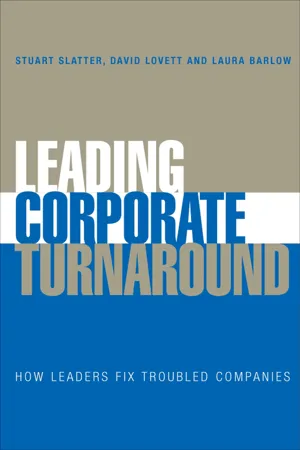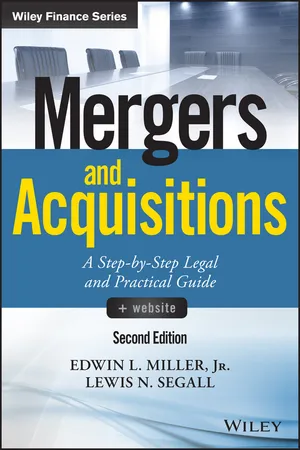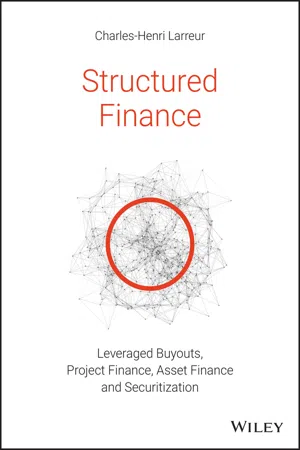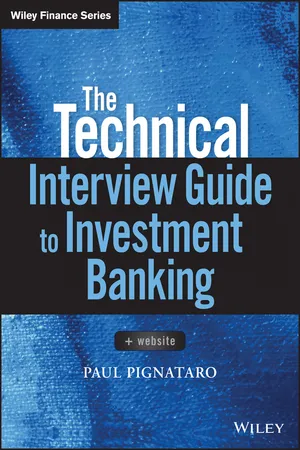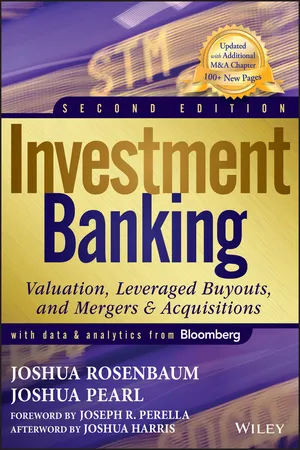Business
Leveraged Restructuring
Leveraged restructuring refers to a strategy where a company uses borrowed funds to acquire another company or to buy back its own shares in order to increase its financial leverage. This can potentially lead to higher returns for shareholders, but it also carries increased financial risk due to the higher levels of debt.
Written by Perlego with AI-assistance
Related key terms
8 Key excerpts on "Leveraged Restructuring"
- eBook - ePub
Leading Corporate Turnaround
How Leaders Fix Troubled Companies
- Stuart Slatter, David Lovett, Laura Barlow, David Lovett, Laura Barlow(Authors)
- 2011(Publication Date)
- Wiley(Publisher)
3. To restore the risk profile (particularly in relation to credit extended to the company) to that accepted at the time of making the original credit available, subject to the requirements of the first two objectives. This is normally measured in terms of leverage and other financial ratios, asset coverage and other covenanted performance criteria.In small and medium-sized companies, the capital structure is usually quite straightforward and depends on a key relationship with one or two domestic lenders. In such cases, the restructuring will often be negotiated directly between the company and its stakeholders, based on the business plan that has been developed as part of the turnaround process. The business plan shows the way to recovery and underlying financial models will indicate what the company can afford by way of debt service and amortisation. The restructuring process becomes considerably more complicated as companies grow and more financial stakeholders become involved in multi-level capital structures. In this chapter we have focused on the role of the restructuring leader in these more complex situations.As in the other critical phases of the turnaround process, the turnaround or restructuring practitioner has to have the ability to “morph” between leadership and management during the financial restructuring process. He or she has to be both a detailed project manager, able to navigate through the fine print of detailed legal and commercial negotiations, and a visionary leader who can clearly articulate a financially viable “desired end state” that preserves greater value for stakeholders than the alternative of insolvency.The leader’s task is both to establish an end game for the process as well as aligning the multiple parties involved, to achieve a successful outcome to the negotiations. Within the firmament of broken promises, lack of initial understanding, and corporate and personal agendas typical of most turnaround situations, even a modest restructuring can quickly involve 50 to a 100 people. If the leader is to be successful, he or she has to bring order, create calm, maintain focus and find a way forward that offends the least number of parties. The law provides for remedies where parties fail to agree, but it is usually the case that the application of insolvency procedures further reduces the value of the enterprise. The alternative, liquidation value is the ultimate yardstick against which the value preserved through a consensual restructuring is measured. - eBook - ePub
Mergers and Acquisitions
A Step-by-Step Legal and Practical Guide
- Edwin L. Miller, Lewis N. Segall(Authors)
- 2017(Publication Date)
- Wiley(Publisher)
CHAPTER 7 Leveraged Buyouts (Structural and Tax Issues) and Acquisitions of a Troubled Business (Creditors' Rights and Bankruptcy)LEVERAGED BUYOUTS: STRUCTURAL AND TAX ISSUES
Introduction
What is a leveraged buyout (LBO)? The term usually is used to describe a transaction where equity investors form a shell company, often including management of the company to be acquired, which acquires an operating business or division using significant debt financing to fund the purchase price. Since the shell company has little borrowing capacity, the borrowing is based in large part on the value of the assets and expected future cash flows of the business to be acquired. The organizer of the LBO is typically an LBO fund. Where there is significant management participation, the transaction is called a management buyout (MBO).Leveraged buyout funds historically have generated extremely high returns for their investors. If that is the case, then why don't the management and selected shareholders of the Target do the same thing without the LBO fund? The answer is they do—via a leveraged recapitalization. A leveraged recapitalization or leveraged recap is a transaction where an operating company levers up and borrows a significant amount of money, using the proceeds to pay a special dividend to its shareholders or buy back some of its shares.Leveraged buyouts are highly complicated transactions, not because there are unusual elements not seen in other transactions but rather, because the transaction is composed of multiple familiar steps, each of which has to be meshed with the others in real time. LBOs are essentially just a combination of mergers and acquisitions practice; debt financing and the relationship between different debt tiers; and the finance and equity elements of starting a new business. There are a few unique issues, however, which we cover here in more depth.Leveraged buyouts can be used to acquire public companies or private companies. Acquisition of a public company is much more complicated, for two basic reasons: The sale is regulated by the Securities and Exchange Commission (SEC) and public transactions attract more scrutiny of the Target's board of directors regarding fulfillment of its fiduciary duties to the Target's stockholders. The board has the same duties in public and private transactions, but, as discussed in Chapter 6 , public acquisitions are more visible and there are many more shareholders who are scrutinizing the performance of the Target board in getting maximum value for the shareholders (and who are willing to sue). Public transactions also attract rival bidders that must find a way to upset the original deal. In private companies, frequently the board members are the representatives of the major shareholders, so there is no real practical dichotomy between the board and the shareholders. Even in our society, you can't sue yourself. Director duties in the acquisition context are discussed in detail in Chapter 6 - eBook - ePub
The Stress Test Every Business Needs
A Capital Agenda for Confidently Facing Digital Disruption, Difficult Investors, Recessions and Geopolitical Threats
- Jeffrey R. Greene, Steve Krouskos, Julie Hood, Harsha Basnayake, William Casey(Authors)
- 2018(Publication Date)
- Wiley(Publisher)
I see now that I was overly optimistic. The lenders asked all the right questions; unfortunately, I was not well prepared and did not have proper business plans, cash flow forecasts, and commercial due diligence to demonstrate why they should support the business. That also meant I had nothing to show other capital providers.Within two months, the business was on the verge of bankruptcy and its debt had been sold to other financial institutions—principally credit funds—which took a clinical view of the loan and demanded repayment. Through a consensual debt-for-equity swap, the funds took control of the business, put in a new management team, and subsequently funded a merger with a competitor.I thought I was in control. It took me too long to realize I wasn’t, and by then it was too late.Every restructuring situation starts as a healthy business with all the hopes of being successful. It is a complex process to return a business to viability after suffering through a period of financial and operational distress. Most restructurings are multidimensional and require a combination of capabilities, including strategic planning, stakeholder management, operational transformation, cash flow management, and M&A expertise—essentially every element of the Capital Agenda. In addition to bringing a diverse set of capabilities together, restructuring increasingly involves an international legal dimension. Legal regimes in developed economies differ, sometimes significantly, in how to address corporate rehabilitation. Understanding the options, strategies, and pitfalls of one restructuring regime versus another requires broad knowledge of multiple legal systems and their relative merits in a particular situation. All of these factors converge to create a rich but complex environment for restoring corporate health—once described as akin to playing chess on a three-dimensional board.The intricacies of restructuring affect each company in a unique way. However, successful restructuring processes have a common set of characteristics. These include: - eBook - ePub
Structured Finance
Leveraged Buyouts, Project Finance, Asset Finance and Securitization
- Charles-Henri Larreur(Author)
- 2021(Publication Date)
- Wiley(Publisher)
PART I Leveraged Buyout (LBO)An LBO or leveraged buyout refers to the acquisition of a company with a combination of equity and debt. It is a financial technique that slowly emerged at the beginning of the twentieth century. LBOs, however, have only really taken off since the early 1980s, around the same time as project finance, asset finance, and securitization.Readers with a background in finance are generally more familiar with LBOs than with the other financing techniques analyzed in this book. LBOs are a topic that might have been encountered in previous reading or studied in a course related to business valuation or corporate finance.Without ignoring the link between corporate finance and LBOs, we think of the LBO as primarily a financing technique. Debt is indeed used to finance the acquisition – via an SPV – of an asset that generates cash flow. LBOs are in this respect similar to the other structures that we will discuss in this book. The main difference is the nature of the asset that is financed. It is a company in the case of an LBO, rather than an infrastructure asset, as in project finance (Part II ), a moveable asset, as in asset finance (Part III ) or a portfolio of receivables, as in securitization (Part IV ).LBOs combine all the elements of structured transactions: (i) use of an SPV; (ii) recourse to financial leverage; and (iii) tax optimization. They tend to get more media attention than other structured finance techniques, probably due to the fact that some companies taken over via LBOs are extremely well known. It is easier to make headlines in the Financial Times with the acquisition of Burger King or Harley‐Davidson than with the financing of a wind farm in Illinois or Colorado.LBOs exemplify probably more than any other technique the series of financial revolutions addressed in this book. It is, therefore, only natural to start our journey with a plunge in the intricacies of leveraged buyouts. We hope that readers who are not familiar with the concept will discover its mysteries. For others, we hope that they will rediscover the spark – and the fun! – of this technique. - Paul Pignataro(Author)
- 2017(Publication Date)
- Wiley(Publisher)
Part Five Leveraged BuyoutsA leveraged buyout is an acquisition of an entity using a significant amount of debt to meet the acquisition cost. Leveraged buyouts are typically conducted by private equity funds designed to acquire businesses with the hope that they can exit the business at a later date, making a return on the investment. An understanding of this topic is necessary for those interested in the private equity industry. The technical leveraged buyout modeling is often seen as complex, and so knowledge of leveraged buyouts would set one apart competitively even in an investment banking interview process. In addition, there are some investment banking groups that do leveraged buyout modeling. If you find an interest or need to review leveraged buyouts in more complete detail, read my book, Leveraged Buyouts.Passage contains an image
CHAPTER 8 Leveraged Buyouts Overview
A leveraged buyout is an acquisition of a company using a significant amount of debt to meet the cost of the acquisition. This allows for the acquisition of a business with less equity (out-of-pocket) capital. Think of a mortgage on a house. If you take out a mortgage to fund the purchase of a house, you can buy a larger house with less out-of-pocket cash (your down payment). Over time, your income will be used to make the required principal (and interest) mortgage payments; as you pay down those principal payments, and as the debt balance reduces, your equity in the house increases. Effectively, the debt is being converted to equity. And maybe you can sell the house for a profit and receive a return. This concept, on the surface, is similar to a leveraged buyout (LBO). Although we use a significant amount of borrowed money to buy a business in an LBO, the cash flows produced by the business will hopefully, over time, pay down the debt. Debt will convert to equity, and we can hope to sell the business for a profit.- eBook - ePub
Private Capital Investing
The Handbook of Private Debt and Private Equity
- Roberto Ippolito(Author)
- 2019(Publication Date)
- Wiley(Publisher)
CHAPTER 9 Leveraged BuyoutINTRODUCTION
A leveraged buyout (LBO) is the acquisition of a whole company or a division thereof (the ‘Target’) financed with an above average level of debt (usually secured). Debt is provided by one or more ‘acquisition finance’ houses (usually banks), is repaid by the Target's cash flow (and sometimes also upon the sale of selected Target's assets), and is secured against the Target's assets. Equity is provided by a private equity fund (the ‘Sponsor’), which takes a relatively small equity investment risk; the Sponsor's objective is to realise an adequate return on its equity investment upon exit (typically through a sale or IPO of the Target). Management usually retains a shareholding that is often incentivised.There are various types of buyout:- management/leveraged buyout, also referred to as (M)LBO: managers acquire a business they have been managing and voting control after the buyout lies with the management team;
- management buy-in (MBI): the management does not already work for the target company, but is taken on by the Sponsor, and will co-invest alongside;
- leveraged build up/platform buyout/roll on: buyout with the intention of making further synergistic acquisitions;
- sponsored spin out: a new company is owned by the previous owners;
- leveraged recap(italisation): a company borrows money in order to make a cash payout to existing shareholders.
In general narrative terms the elements of a typical LBO can be summarised as follows: the first stage involves raising the necessary funds (debt and equity) and establishing a management incentive system. Normally the investor group (led by the Sponsor and the company's top management) provides 30–50% of the price paid (also called the ‘Transaction Value’), while the remainder is provided by the lenders (banks, specialised debt providers, and/or capital market). At the second stage, the Sponsor purchases all (or the vast majority) of the outstanding shares of the Target or the assets of the company. At the third stage, the management implements operating efficiencies (cost cutting, asset optimisation) and executes eventual growth strategies (mainly via acquisitions) so as to increase profits and cash flow. In the last stage (after the majority or whole acquisition/LBO debt has been repaid), the Sponsor sells the Target. Financial sponsors generally seek to exit in three to five years. There must be a clear route to exit, to be established before the close of the deal: potential exit routes include IPO, trade sale, leveraged recapitalisation, and break-up. - No longer available |Learn more
Investment Banking
Valuation, Leveraged Buyouts, and Mergers and Acquisitions
- Joshua Rosenbaum, Joshua Pearl(Authors)
- 2013(Publication Date)
- Wiley(Publisher)
PART Two Leveraged BuyoutsPassage contains an image
CHAPTER 4 Leveraged Buyouts
A leveraged buyout (LBO) is the acquisition of a company, division, business, or collection of assets (“target”) using debt to finance a large portion of the purchase price. The remaining portion of the purchase price is funded with an equity contribution by a financial sponsor (“sponsor”). LBOs are used by sponsors to acquire control of a broad range of businesses, including both public and private companies, as well as their divisions and subsidiaries. The sponsor's ultimate goal is to realize an acceptable return on its equity investment upon exit, typically through a sale or IPO of the target. Sponsors have historically sought a 20%+ annualized return and an investment exit within five years.In a traditional LBO, debt has typically comprised 60% to 70% of the financing structure with equity comprising the remaining 30% to 40% (see Exhibit 4.12 ). The disproportionately high level of debt incurred by the target is supported by its projected free cash flow1 and asset base, which enables the sponsor to contribute a small equity investment relative to the purchase price. The ability to leverage the relatively small equity investment is important for sponsors to achieve acceptable returns. The use of leverage provides the additional benefit of tax savings realized due to the tax deductibility of interest expense.Companies with stable and predictable cash flow, as well as substantial assets, generally represent attractive LBO candidates due to their ability to support larger quantities of debt. Free cash flow is needed to service periodic interest payments and reduce the principal amount of debt over the life of the investment. In addition, a large tangible asset base increases the amount of bank debt - eBook - ePub
Investment Banking
Valuation, LBOs, M&A, and IPOs
- Joshua Rosenbaum, Joshua Pearl(Authors)
- 2020(Publication Date)
- Wiley(Publisher)
PART Two Leveraged BuyoutsPassage contains an image
CHAPTER 4 Leveraged BuyoutsA leveraged buyout (LBO) is the acquisition of a company, division, business, or collection of assets (“target”) using debt to finance a large portion of the purchase price. The remaining portion of the purchase price is typically funded with an equity contribution by a financial sponsor (“sponsor”) or equivalent. LBOs are used by sponsors to acquire control of a broad range of businesses, including both public and private companies, as well as their divisions and subsidiaries. The sponsor’s ultimate goal is to realize an acceptable return on its equity investment upon exit, typically through a sale or IPO of the target. Sponsors tend to seek a 15% to 20% annualized return and an investment exit within five years. PE funds range in size from tens of millions to tens of billions of dollars, and some sponsors manage numerous funds.In a traditional LBO, debt typically comprises 60% to 70% of the financing structure with equity comprising the remaining 30% to 40% (see Exhibit 4.12 ). The relatively high level of debt incurred by the target is supported by its projected free cash flow1 and asset base, which enables the sponsor to contribute a small equity investment relative to the purchase price. The ability to leverage the relatively small equity investment is important for sponsors to drive acceptable returns. The use of leverage provides the additional benefit of tax savings realized due to the tax deductibility of interest expense.Companies with stable and predictable cash flow, as well as substantial assets, generally represent attractive LBO candidates due to their ability to support larger quantities of debt. Free cash flow is needed to service periodic interest payments and reduce the principal amount of debt over the life of the investment. In addition, a large tangible asset base increases the amount ofsecured debt
Index pages curate the most relevant extracts from our library of academic textbooks. They’ve been created using an in-house natural language model (NLM), each adding context and meaning to key research topics.
